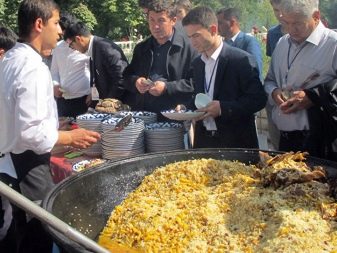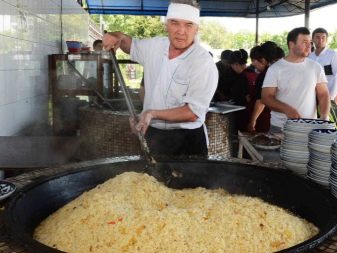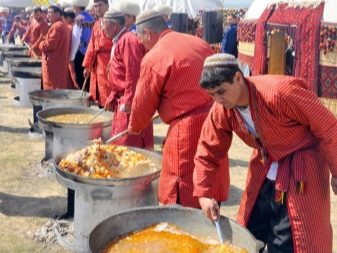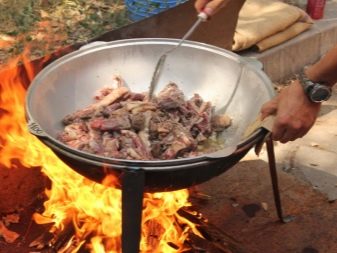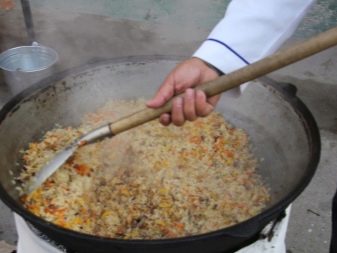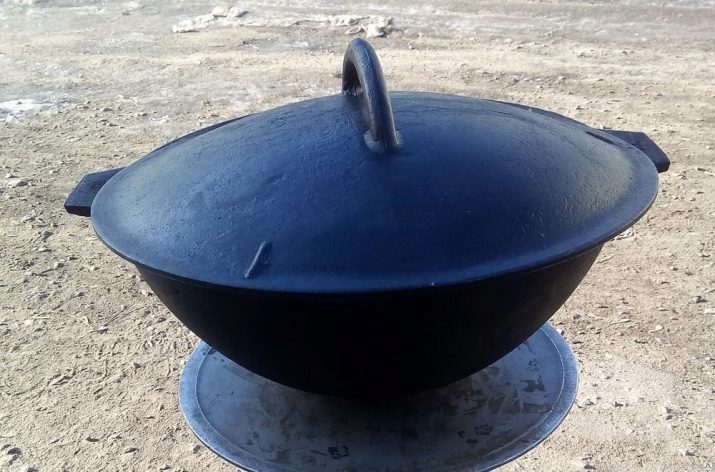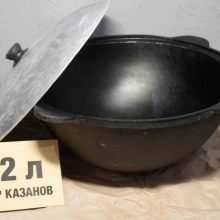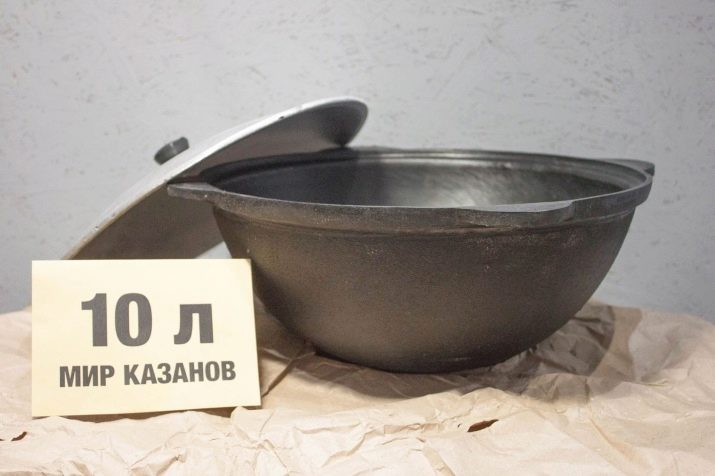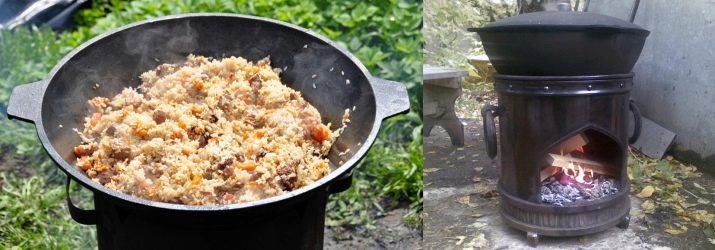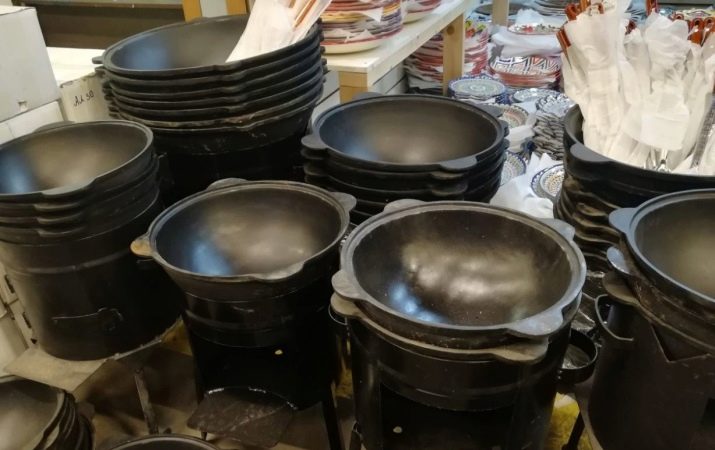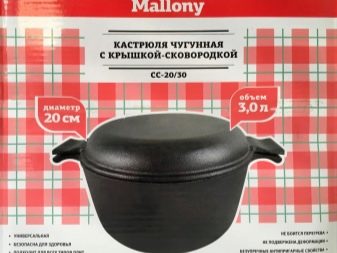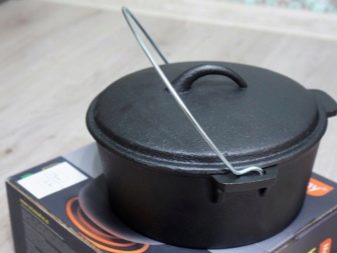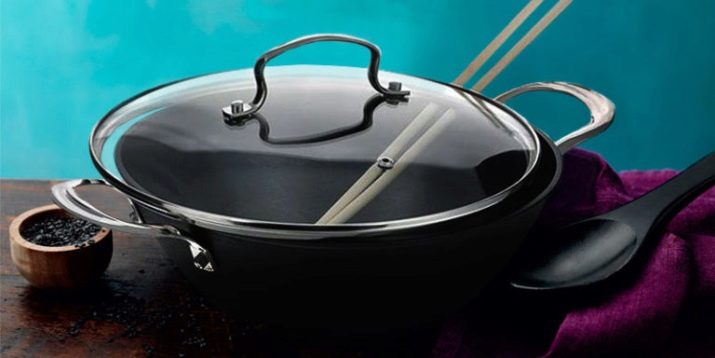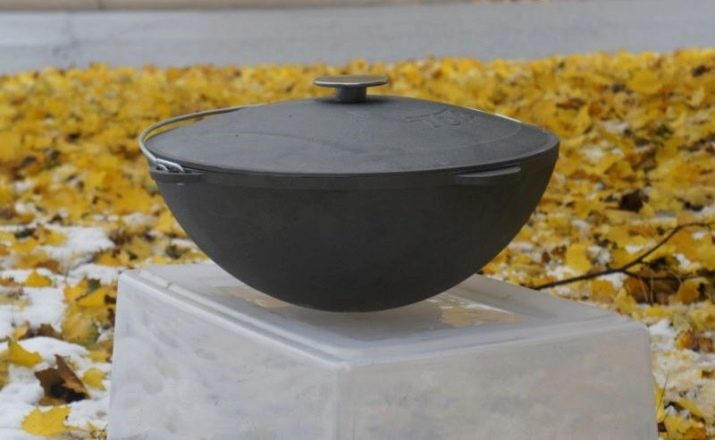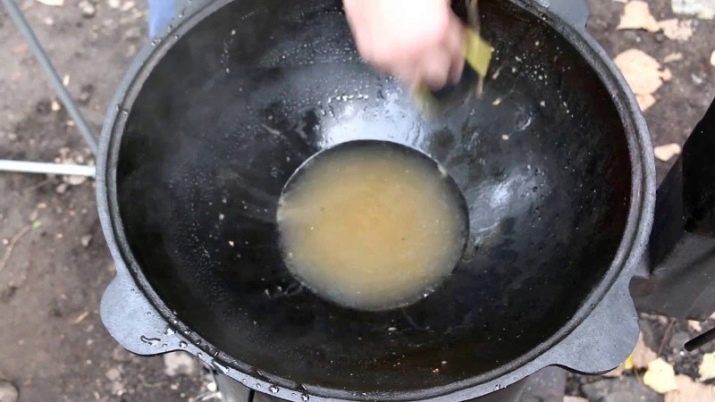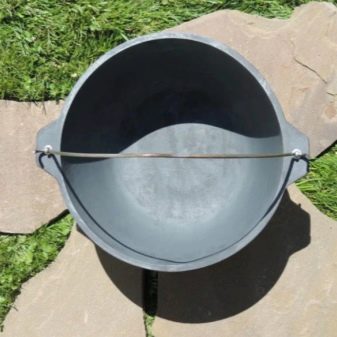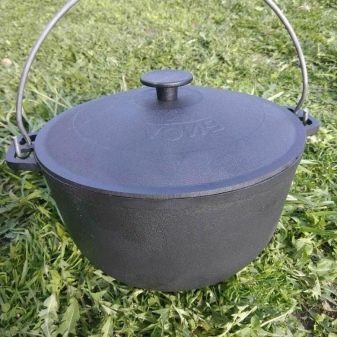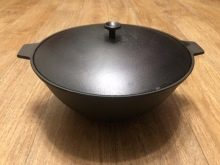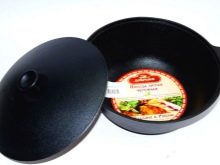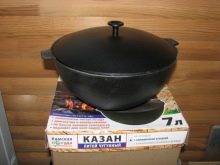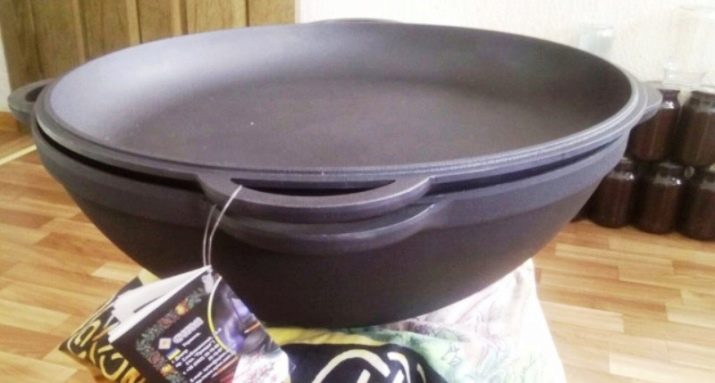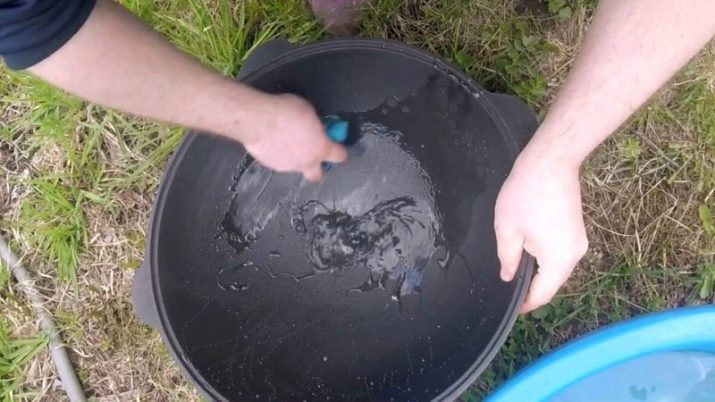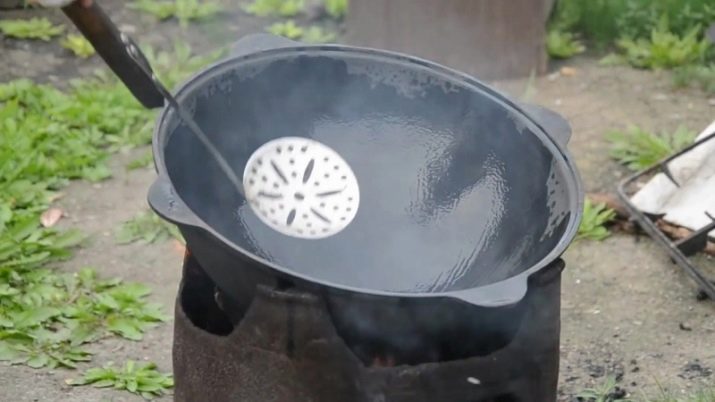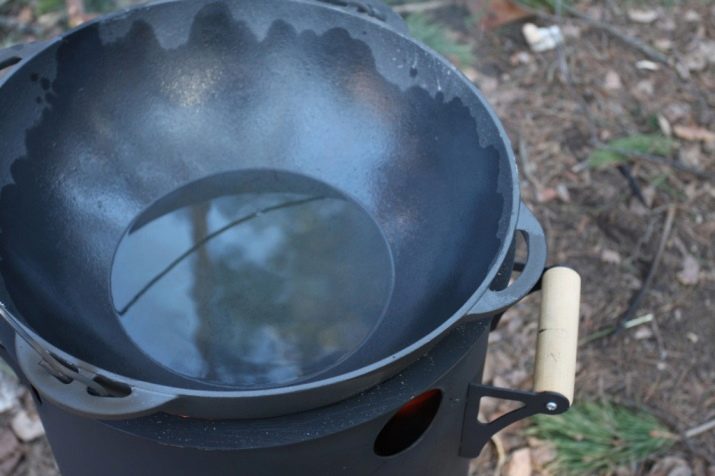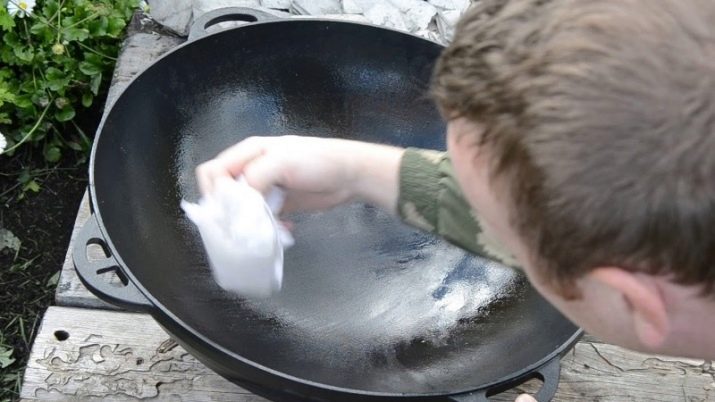Kazan - having a long history of dishes, which has not lost its relevance in our day. The dishes prepared in it come out very juicy, fragrant and appetizing. The best material for the production of a cauldron is cast iron.
Description
Kazan is considered the national dishware of the inhabitants of Central Asia - Tajikistan, as well as Uzbekistan and Turkmenistan. Traditionally, it is made of cast iron, and this utensil has great fame - the food is not cooked in such dishes, and as if stewed, this process takes quite a long time but the dishes are incomparable in taste.
The cauldron is a large pot of metal with thickened walls and a rounded bottom, it is ideal for cooking meat, pilau, shurpy and many other dishes. And the cauldron is equally suitable for use on the stove, and on an open fire.
Cooking in a cauldron has its own specifics and includes two stages.
- Initially food is cooked on fire. - the flame burns directly under the bottom. At this point, fat is melted down and meat products are roasted.
- At the second stage, there is no longer any open fire, and the heat comes from the remaining coal. At this point, you can add to the cauldron grits and vegetables, which for cooking need a gentle heating mode of low intensity.
By the way the older the dishes, the more delicious and appetizing the dishes in it. This is simply explained - in the course of use, a film remains on the walls and the bottom, which is not washed off, thus all pores, even the smallest ones, become clogged with grease over time.
The film prevents the products from sticking to the walls, and a very effective coating is created that prevents the products from burning.
Advantages and disadvantages
Pig-iron cauldrons have their advantages and disadvantages.
The advantages include:
- slow heating;
- uniform redistribution of heat;
- prolonged maintenance of temperature after the cauldron is removed from the heat source;
- the tight lid prevents the pair from escaping;
- practicality and durability.
Cooked in a cauldron meat, vegetables and cereals almost completely retain all their nutrients and vitamins. When cooking does not emit toxins and carcinogens - the food is extremely healthy and healthy.
By cons include:
- heaviness - dishes from cast iron have a rather impressive mass, therefore it is not always convenient to use;
- susceptibility to corrosion and rust;
- cast iron cookware is not particularly aesthetic.
Varieties and sizes
As a rule, in the cast iron cauldrons a wide variety of food is prepared - from 2 to 20 liters. The most common cauldrons for 8 liters and 12 liters. When buying a cauldron, keep in mind that the manufacturer usually indicates the maximum capacity and not the operating parameter, as the cauldron is usually not completely filled.
Calculate the full capacity of the container should be based on the total number of persons on whom the preparation of the dish will be calculated. So, for 2-3 people, a cauldron with a capacity of 5 liters will be quite enough; for 5-6 people, a cauldron of 8-10 liters should be preferred, for 10 and more people it is better to purchase large-sized cauldrons designed for 16-20 liters.
Depending on the configuration, cauldrons are with or without a lid, with removable handles.The bottom can be enameled with either a non-stick coating, and the shape can be flat or rounded.
Sale special cauldrons with a stove, which facilitates the process of cooking any dish. Typically, these products come with various useful accessories - skimmer, poker, potholder, a set of spices.
Manufacturers Overview
It is believed that the highest quality cauldrons are Uzbek, especially those made in Namangan. This is where the real classic dishes made of the highest quality cast iron are made. This is the main advantage of products in comparison with cauldrons made in Russia, Ukraine and Belarus, in which, in addition to iron, aluminum and copper additives are used.
Central Asian dishes are made mainly by hand, automated equipment is almost never used.
Mallony brand cast-iron cauldrons are very popular with consumers. This dish appeared in the trade enterprises of our country in 2004 and immediately won the recognition of the Russians due to its high quality and good equipment. However, these cauldrons have their own characteristics.
- First, they do not recommend storing food.otherwise, corrosion processes begin rather quickly. After each wash, wipe the external and external walls dry and treat with heated vegetable oil.
- Secondly, the model does not have a non-stick coating.therefore, the burning of products is not excluded.
- Third, cauldrons of this brand are very afraid of temperature changes.therefore, they can be used only on the stove - it is not worth putting cauldrons on the fire, and also in the oven. Cold dishes should not be loaded into dishes and filled with cool water.
All these shortcomings are significantly outweighed by the fairly democratic cost - finding cheaper cauldrons in stores simply will not work, and if properly used, they will serve faithfully for many years.
Mayer & boch - another popular manufacturer of cast iron cauldrons. The products of this brand is optimal for the preparation of pilau, stews, all types of goulash and even soups. The bottom is covered with high-quality non-stick coating, so that the food is prepared not burning, and the product itself is characterized by durability and durability. Cauldrons are equipped with a glass lid and steel handles, cooking in such a cauldron is possible on any stove, including induction, can be used in stoves and open flame.
The service life of such cauldrons reaches 30 years.
"Seaton" - another manufacturer of cast iron cauldrons. It is important that the manufacturer uses a system to protect the material from food acids, which often spoil the metal. A distinctive feature of cauldrons of this brand is black matte color and exceptional strength.
The ware is completed with a brush for putting oil.
Of the minuses - a lot of weight, moving and washing such dishes is quite difficult. During cooking, the lid heats up, so when working, be sure to use gloves. However, such dishes are cleaned in minutes, the products do not stick or stick in the cooking process. The cauldron can be used on any stoves, in furnaces, and also on a fire.
"Biol" Is a company producing authentic Tatar cast iron cauldrons, which are suitable for cooking any dishes on an open fire, but can also be used on plates. Such dishes perfectly keeps the heat and gives the food an unusual taste. The company has a very good reputation, but buyers warn that the manufacturer does not spare the engine oil to treat the walls of the vessel, so the cauldron should certainly be hardened before first use.
Cauldrons of the Kama dishes and Dobrynya brands are also in demand.
How to choose?
When choosing a cauldron it is necessary to take into account several important aspects.
- Most of the products on sale have a hemispherical shape with a rounded bottom.This design allows the use of dishes for cooking on an open flame, usually used with a tripod.
- It is advisable to buy cauldrons, the density of the walls of which is 3-5 cm. If you purchase a model with thinner walls, then the product will serve you not so long. Despite the low cost of such a model, it is not in demand.
- Keep in mind that the denser the walls of a cauldron, the more efficiently heat will accumulate in it, and the ready dish will turn out to be more delicious and juicy.
- It is very important to inspect the internal cavity of the walls for the presence of cavities, irregularities, chips and cracks - any of these defects is a reason to refuse to purchase, since they significantly complicate the heating of the prepared products.
- Before you buy, be sure to determine for which dishes and on what types of fire you plan to use the product. If you plan to cook on a traditional gas or electric household stove, then you should give preference to copper or aluminum models, cast iron are intended for frequent use on fire, as well as in a furnace, and it is desirable to buy them with a lid.
- When choosing a suitable model, be sure to consider the design issue of the furnace and its depth.
How to prepare for first use?
After acquiring the cauldron should be prepared for the very first use at home, for this you should perform a few simple operations.
First you need to wash off the factory grease. You can use ordinary water from the tap with gel-like detergents.
It is necessary to set the maximum heating mode and calcify the cauldron for about 2-2.5 hours. During processing, it is necessary to turn the dishes from one side to the other from time to time.
As soon as the smoke from the cauldron stops going, we can assume that the lubricant has burned down completely. Immediately after this, it is necessary to wipe the inner surface of the container with a soft cloth, pour a pack of salt inside and calcine the cauldron for about an hour - during this time the salt will absorb all the metallic impurities with unnecessary elements and salt will gray.
Calcination is repeated, but now with vegetable oil. For processing it will take 350-400 ml, the procedure lasts about 25-30 minutes. During this time, the oil begins to envelop the walls of the cauldron and clogs the pores of the material. The remaining oil should be drained, after which the cauldron is cooled and sent for storage in a clean, dry place.
There is another way to prepare cauldron for use.
Using paper napkins, it is necessary to clean all the oil, after which the boiler is turned upside down and in this position is placed in a preheated oven.
Dishes should be roasted for about an hour at a temperature of 220-230 degrees. This time is enough for complete processing of cast iron.
At the final stage, the cauldron is rubbed with sunflower oil and sent for storage.
How to care?
In the process of cooking in a cauldron, a thin film is formed from the oil and fat, which effectively protects the material from corrosion and also adds greater juiciness and aroma to the dish. If you remove such a film, the food in the cooking process will start to burn, which is why when cleaning the cauldron it is not recommended to use abrasive compounds and metal brushes.
If the products are still burned, then you need to pour a little water into the cauldron, add a couple of tablespoons of soda and salt and boil over medium heat for about half an hour. When the water has cooled, you will need to clean the internal surfaces with a soft sponge and detergent.
As you know, cast iron has the ability to absorb the smell, so from time to time you need to carry out the following processing cauldron - you need to put the dishes on a large fire, pour out a packet of salt and calcined for 30-40 minutes. Salt must be constantly stirred and distributed on the walls - during processing it will absorb all the odors and at the same time remove soot.
After processing, salt is poured out, and the inner surface is wiped dry with a napkin, after which the container is lubricated with heated oil and again roasted for about 20 minutes.
In order for the cauldron not to rust, it needs care. Immediately after cooking, remove all food residue, rinse with water and detergent, and then dry with paper napkins or by roasting.
If you still could not avoid corrosion, then you can save the situation. To do this, stir the water with vinegar in a 1: 1 ratio, pour it into a large basin and keep the cauldron in it for about an hour. After this, the container is dried, coarse salt is placed on the bottom and rubbed on all walls and bottom. So you remove rust from surfaces.
How and how to wash a cast iron cauldron, see the following video.


